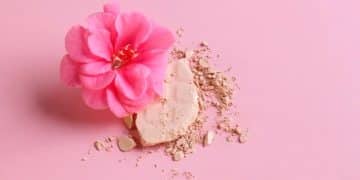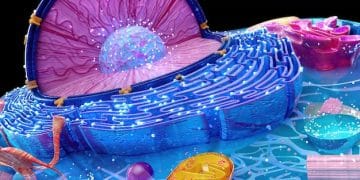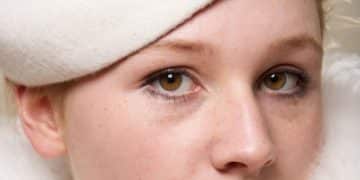The Ultimate Guide to Understanding Makeup Expiration Dates in 2025
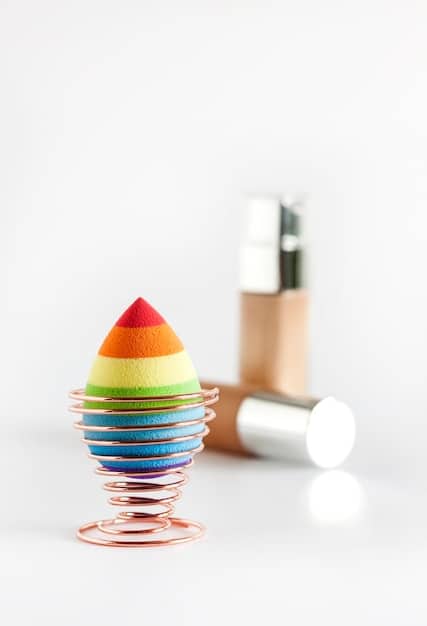
Understanding makeup expiration dates in 2025 is crucial for maintaining product efficacy, preventing bacterial contamination, and ensuring consumer safety, as products lose stability and hygienic integrity over time.
In the dynamic world of beauty, where new products and formulations continuously emerge, one aspect remains timeless yet often overlooked: the shelf life of your cosmetics. Mastering The Ultimate Guide to Understanding Makeup Expiration Dates in 2025 is not just about avoiding waste; it’s fundamental for maintaining skin health and ensuring the efficacy of your beauty regimen.
The Science Behind Makeup Shelf Life
Understanding why makeup expires goes beyond a simple date on a package; it delves into the intricate science of cosmetic formulation. From the moment a product is opened, it begins a subtle, yet inevitable, journey of degradation, influenced by a myriad of factors. This process isn’t random; it’s a carefully studied phenomenon crucial for consumer safety and product performance.
Cosmetic products are complex mixtures of water, oils, waxes, pigments, preservatives, and active ingredients. Each component plays a role in the product’s stability and shelf life. Water-based products, for instance, are inherently more susceptible to microbial growth than anhydrous (water-free) formulations, making their expiration dates shorter.
Understanding PAO and Expiration Symbols
When you examine a makeup product, you’ll likely encounter a few key symbols that indicate its longevity. The most common is the “Period After Opening” (PAO) symbol, which looks like an open jar with a number and the letter “M” inside (e.g., “6M” for six months, “12M” for twelve months). This symbol indicates the recommended timeframe during which the product should be used after it has been opened.
- The PAO symbol generally applies to products once their seal is broken, exposing them to air and potential contaminants.
- A common misconception is that a product is good indefinitely until opened. While sealed products can last longer, they also have an inherent shelf life, often indicated by a traditional “best by” date or manufacturing code.
- The expiration date (EXP) is typically found on the packaging and signifies the end of the product’s guaranteed stability and efficacy, regardless of whether it’s been opened. This is more common for products with strict sterility requirements, like mascaras or liquid eyeliners, or those containing active pharmaceutical ingredients.
Preservatives, a critical component in most cosmetic formulations, are designed to inhibit the growth of bacteria, fungi, and yeasts. Over time, however, these preservatives can break down or become less effective, especially after repeated exposure to air and contaminants from application tools or fingers. This reduced preservative efficacy is a primary reason products expire, leading to potential microbial proliferation.
Factors Accelerating Product Degradation
Several external factors can significantly accelerate the degradation of makeup products, shortening their effective shelf life even before their indicated PAO or expiration date. Being mindful of these factors can help extend the life of your cosmetics, within safe limits.
- Temperature Fluctuations: Storing makeup in environments with extreme temperatures, such as a hot car or a steamy bathroom, can break down emulsions, degrade active ingredients, and compromise preservative systems.
- Direct Sunlight Exposure: UV light can alter the chemical structure of ingredients, leading to color changes, loss of efficacy, and increased susceptibility to bacterial growth. This is particularly true for products in clear packaging.
- Air Exposure: While the PAO symbol accounts for initial air exposure, prolonged or excessive exposure (e.g., leaving caps off or jars open) can lead to oxidation, ingredient evaporation, and increased contamination risks.
- Contamination: Introducing bacteria from fingers, dirty brushes, or sponges directly into the product is one of the quickest ways to compromise its integrity and accelerate spoilage, regardless of its original expiration date.
Ultimately, the science of makeup shelf life is a delicate balance of formulation stability, preservative efficacy, and proper storage and handling. Adhering to manufacturer guidelines and being aware of the signs of spoilage are key to safe and effective beauty practices.
Decoding Common Makeup Expiration Dates in 2025
As we navigate the beauty landscape of 2025, understanding the typical expiration timelines for various makeup categories remains crucial. While general guidelines exist, individual product formulations and how they are stored can influence their actual longevity. Knowing these benchmarks empowers you to make informed decisions about your makeup collection.
Mascaras and Liquid Eyeliners: The Shortest Shelf Life
These products come into direct contact with the eyes, which are highly sensitive and susceptible to infection. Their liquid formulation also makes them a prime breeding ground for bacteria.
- General Expiration: 3-6 months.
- Why so short? Every time the wand is pulled out, it introduces air and bacteria. The dark, moist environment of the tube is ideal for bacterial growth. Using expired mascara can lead to eye infections, conjunctivitis, or styes.
It’s often advised to replace mascara every three months, even if it hasn’t technically reached its PAO, to minimize the risk of bacterial contamination. If it starts to smell strange, become clumpy, or cause irritation, discard it immediately. Never share mascara or liquid eyeliner.
Foundations and Concealers: Varying by Type
The shelf life of complexion products can vary significantly depending on their formulation – liquid, cream, stick, or powder.
- Liquid and Cream Foundations/Concealers: 6-12 months.
- These water-based formulations are more prone to bacterial growth. Signs of spoilage include separation, change in color or smell, and an altered consistency.
- Stick Foundations/Concealers: 12-18 months.
- Less exposure to air and often contain fewer water-based ingredients, giving them a slightly longer lifespan. Still, direct application to skin can transfer bacteria.
- Powder Foundations: Up to 2 years.
- Their lack of water content makes them less hospitable for bacteria. However, brushes used to apply them still need regular cleaning.
For liquid and cream products, consider using a pump dispenser or a spatula instead of dipping fingers directly into the product to prolong its life and minimize contamination.
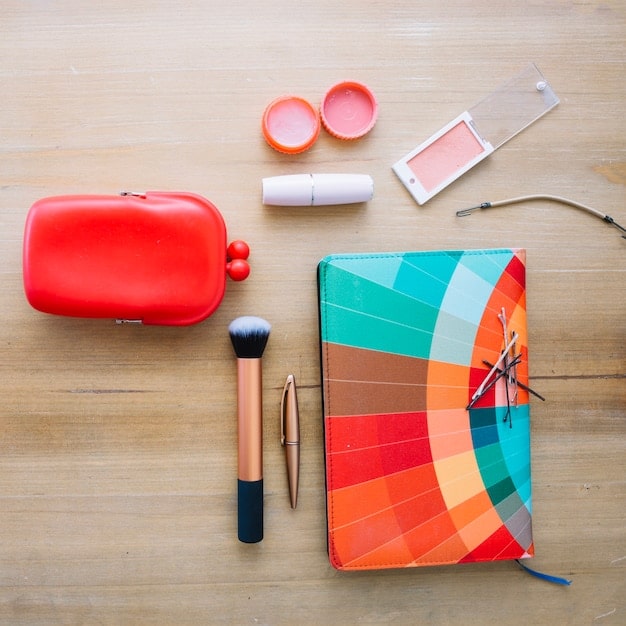
Lip Products: Balms, Glosses, and Lipsticks
Lip products are a mixed bag when it comes to expiration, largely due to their texture and direct contact with the mouth.
- Lip Glosses: 6-12 months.
- Similar to liquid foundations, the wand applicator can introduce bacteria. Watch for changes in stickiness, smell, or color.
- Lipsticks and Lip Balms (Sticks): 1-2 years.
- Their waxier, less water-based nature gives them more longevity. However, if they dry out, become crumbly, or develop a waxy odor, it’s time to replace them.
- Lip Pencils: Up to 3 years.
- Often have a longer shelf life due to their harder, dry formulation. Sharpening them regularly can also remove compromised layers.
Avoid sharing lip products, as they can easily transfer bacteria and viruses. If you’ve had a cold sore, it’s best to discard any lip product used during that time.
Powder Products: Eyeshadows, Blushes, Bronzers
Powder products generally have the longest shelf life because bacteria struggle to thrive in dry environments.
- General Expiration: 1-2 years, up to 3 years for some.
- Key for Longevity: The main threat to powder products is consistent moisture exposure paired with unhygienic application, which can lead to mold growth.
Regularly clean your brushes and sponges used with powder products. If you notice a hard, shiny film (known as “hard pan”), or any changes in texture, color, or smell, it’s a sign they may be compromised, possibly from oils and moisture transferred from the skin.
Pencil Liners and Brow Pencils: The Longest Lasting
Due to their dry formulation and the ability to sharpen away the exposed tip, pencils tend to last the longest.
- General Expiration: 1-3 years.
- Tip for Longevity: Regular sharpening not only keeps the tip precise but also removes any potential bacterial buildup on the surface, making them inherently more hygienic than their liquid counterparts.
While pencil liners and brow pencils are quite durable, pay attention if the texture changes, they become brittle, or if there’s any unusual odor. These are indicators that the product is past its prime.
By understanding these approximate timelines for various makeup categories, you can manage your beauty stash more effectively, ensuring you’re using products that are both effective and safe for your skin and eyes.
Spotting the Signs of Expired Makeup
Beyond checking the official symbols and dates, your senses are powerful tools in determining if a makeup product has gone bad. Trusting your instincts and being attentive to subtle changes can prevent potential skin reactions or infections. An expired product often communicates its state through noticeable alterations, even if it hasn’t reached its marked expiration date.
Changes in Texture and Consistency
One of the most obvious indicators that your makeup has expired is a noticeable change in its texture or consistency. What begins as a smooth, uniform product can undergo significant transformations.
- Separation: Liquid foundations or concealers might separate into distinct layers of oil and pigment, even after shaking. This is a clear sign that the emulsion has broken down.
- Clumping/Drying Out: Mascara that becomes excessively clumpy, flaky, or dry and starts to pull on your lashes indicates it’s past its prime. Similarly, cream products might feel stiff or crumbly.
- Hardening: Gel eyeliners or cream blushes can harden or develop a film on the surface, making them difficult to apply smoothly.
- Thinning/Thickening: Some liquid products might become unusually thin and watery, losing their original coverage, while others, like nail polish, might become excessively thick and stringy.
These textural changes not only affect the product’s performance but also its ability to be safely applied. Applying a clumpy mascara, for instance, can lead to micro-abrasions in the eye area, increasing the risk of infection.
Alterations in Scent and Color
Your nose and eyes are critical detectors of spoilage. Makeup, especially those containing oils or natural ingredients, can develop unpleasant odors as they oxidize or as bacteria multiply.
- Unusual Odor: A fresh makeup product typically has a neutral or pleasant, subtle fragrance, or no scent at all. If you detect a rancid, sour, musty, metallic, or chemical smell, it’s a strong indicator of spoilage. This is particularly common in products containing oils, which can go rancid over time.
- Color Changes: Pigments can degrade, leading to shifts in the product’s original color. A foundation might turn orange, eyeshadows might lose their vibrancy, or lipsticks might develop an odd hue. This often results from oxidation or chemical reactions within the formula.
These sensory cues are particularly important because they often appear before the product causes any visible irritation on the skin. Catching these signs early is key to preventing adverse reactions.
Appearance of Mold or Bacteria
While less common with proper storage and usage, visible signs of mold or bacterial growth are definitive indicators that a product must be discarded immediately. This is particularly true for products that have been exposed to moisture or unhygienic practices.
- Small Dots or Discoloration: Look for tiny black, green, or white dots, or general fuzzy patches, especially on powder products or around the rim of jars.
- Unusual Film or Growth: A slimy or fuzzy film on the surface of liquid or cream products.
If you see any of these signs, do not try to scrape off the mold or mix the product. The contamination is likely deeper within the product, and using it could lead to severe skin infections, rashes, or allergic reactions.
Regularly inspecting your makeup for these tell-tale signs should be an integral part of your beauty routine. When in doubt, it’s always safer to discard a product than risk the health of your skin and eyes.
Best Practices for Extending Makeup Shelf Life
While makeup products inevitably expire, adopting smart storage and hygiene habits can significantly extend their useful life within safe parameters. These practices not only help you get the most out of your beauty investments but also minimize the risk of contamination and skin irritation.
Proper Storage Techniques
The environment in which you store your makeup plays a crucial role in its longevity. Protecting products from environmental stressors can help preserve their integrity.
- Cool, Dry Place: Store makeup in a cool, dry place away from direct sunlight and humidity. The bathroom, while convenient, is often the worst place due to fluctuating temperatures and high humidity that can encourage bacterial growth and break down formulations.
- Airtight Containers: Always ensure caps, lids, and pumps are tightly closed after each use. Excessive air exposure can lead to oxidation, evaporation of volatile ingredients, and increased contamination.
- Original Packaging: Keep products in their original packaging whenever possible, especially if they came in opaque containers that protect them from light.
For some sensitive products, like natural or organic items with fewer preservatives, storing them in a dedicated beauty fridge can be beneficial, but it’s not a universal requirement for all makeup.
Maintaining Impeccable Hygiene
Contamination is the fastest route to makeup spoilage. Practicing meticulous hygiene is paramount in extending the life of your products, especially those that come into direct contact with the skin or eyes.
- Wash Your Hands: Always wash your hands thoroughly before touching your makeup, particularly products in jars or pots that you dip your fingers into.
- Clean Your Tools: Regularly clean your makeup brushes and sponges. Dirty tools are a major source of bacteria that can be transferred directly to your products, accelerating their degradation. Brushes for liquid products should be cleaned weekly, while those for powders can be cleaned every 2-4 weeks.
- Avoid Double-Dipping: For liquid or cream products in jars, use a clean spatula or applicator to scoop out the product instead of dipping your fingers or a used brush repeatedly.
- Never Add Water or Saliva: Do not add water or saliva to thin out dried-up products like mascara or eyeliner. This introduces bacteria and compromises the product’s preservative system, making it unsafe to use.
Personal hygiene extends to not sharing makeup. Even with close friends or family, sharing products like mascara, lip gloss, or eyeliner can transfer bacteria and viral infections, regardless of how new the product is.
Recognizing When to Discard
Even with the best practices, some products reach their end. It’s crucial to know when to let go, especially when signs of spoilage appear, regardless of the marked expiration date.
- Smell, Texture, Color Changes: If the product smells off, has separated, changed color, or acquired an unusual consistency, it’s time to discard it. These are your primary sensory indicators.
- Eye Products are Priority: Be extra vigilant with eye makeup (mascara, liquid eyeliner). Any sign of clumping, unusual smell, or reaching the 3-6 month mark post-opening is a cue to replace.
- Post-Infection: If you’ve had an eye infection (like pink eye) or a cold sore, discard any makeup that came into contact with the affected area, as it likely harbors bacteria or viruses that could cause reinfection.
By integrating these practices into your beauty routine, you not only ensure the longevity of your makeup but, more importantly, safeguard the health of your skin and eyes from potential contamination and irritation.
The Risks of Using Expired Makeup
While the allure of getting every last drop out of a beloved product is strong, using expired makeup carries tangible risks that extend beyond diminished performance. These risks primarily involve bacterial contamination, leading to a range of skin and eye issues that can be uncomfortable, unsightly, and in some cases, serious.
Skin Irritation and Allergic Reactions
As makeup products age, their chemical composition can change. Preservatives may degrade, oils can go rancid, and active ingredients might break down into irritating compounds. This altered chemistry can trigger adverse reactions on the skin.
- Rashes and Redness: Expired products can cause localized redness, itching, or a bumpy rash, particularly for individuals with sensitive skin.
- Breakouts and Acne: The breakdown of ingredients or the proliferation of certain bacteria in expired makeup can clog pores and exacerbate acne or cause new breakouts.
- Contact Dermatitis: Severe reactions can result in contact dermatitis, an inflammatory skin condition characterized by intense itching, blistering, and scaling, typically where the expired product was applied.
The skin’s protective barrier can be compromised by these reactions, making it more vulnerable to further irritation or infection from other sources.
Eye Infections and Contamination
Eye makeup carries the highest risk when it comes to expiration due to the delicate nature of the eyes and their susceptibility to infection. Liquid and cream eye products are particularly prone to bacterial growth.
- Conjunctivitis (Pink Eye): One of the most common risks. Bacteria from expired mascara or eyeliner can easily transfer to the eye, causing inflammation of the conjunctiva, leading to redness, itching, discharge, and discomfort.
- Styes and Blepharitis: Bacterial contamination can lead to styes (painful bumps on the eyelid) or blepharitis (inflammation of the eyelid margins), characterized by redness, itching, and flaky debris.
- Corneal Infections: In severe cases, bacteria can cause more serious corneal infections, potentially leading to pain, vision impairment, and requiring medical intervention.
Even subtle irritation from expired eye makeup can increase the risk of infection by causing micro-abrasions that allow bacteria to enter. This is why professionals consistently recommend strict adherence to expiration dates for eye products.
Diminished Product Performance and Efficacy
Beyond safety concerns, using expired makeup also means compromising on the very reason you bought the product in the first place: its performance.
- Altered Pigmentation: Colors may appear faded, patchy, or change their hue altogether, making them less effective in achieving the desired look.
- Poor Application: Textural changes, such as clumping, flaking, or separation, make products difficult to apply smoothly, resulting in an uneven or unnatural finish.
- Reduced Longevity: Expired products may not wear as long as fresh ones, leading to premature fading, smudging, or creasing throughout the day.
- Loss of Active Ingredients: For products with skincare benefits (e.g., foundations with SPF or hyaluronic acid), active ingredients degrade over time, rendering them ineffective.
The economic temptation to stretch the life of an expensive product almost never outweighs the potential health risks and unsatisfactory results. Prioritizing your skin’s well-being and the quality of your makeup application means respecting those expiration dates.
Recycling and Disposing of Expired Makeup Responsibly
Once you’ve identified expired makeup, the next step is responsible disposal. Simply tossing products into the general waste bin might not be the most environmentally friendly option, given the diverse materials and chemical compositions involved. As awareness of environmental impact grows, many communities and brands are offering better disposal solutions for 2025.
Understanding Makeup Components
Makeup packaging typically consists of various materials: plastics, glass, metals, and sometimes paper. The product itself, whether liquid, cream, or powder, may contain ingredients that are not suitable for regular wastewater systems or landfills.
- Plastics (e.g., compacts, tubes, bottles): Often recyclable, but need to be cleaned of product residue.
- Glass (e.g., foundation bottles): Highly recyclable, but also require cleaning.
- Metals (e.g., aluminum tubes): Recyclable.
- Product Residue: While small amounts might be fine in the trash, larger quantities of liquid or chemical-heavy formulas should ideally not go down the drain.
The first step in responsible disposal is often to clean out the containers as much as possible, separating the different materials where feasible.
Brand Recycling Programs and Initiatives
Many beauty brands and retailers are increasingly offering specialized recycling programs for their packaging, acknowledging the unique challenges of cosmetic waste. These programs provide a more sustainable alternative to curbside recycling, especially for components that are hard to recycle locally.
- In-Store Drop-Offs: Programs like Pact Collective or Terracycle partner with beauty brands and retailers to establish in-store collection points for empty beauty packaging from any brand. These collected items are then sorted and properly recycled or upcycled.
- Mail-Back Programs: Some brands offer mail-back options where you can send your empty packaging directly to them for recycling. This is often seen with higher-end or sustainability-focused brands.
Before throwing away any empty or expired product, check the brand’s website or visit a local beauty retailer to see if such programs are available in your area. This ensures that valuable materials are diverted from landfills and properly processed.
Home Disposal for Product Itself
For the makeup product itself (the formula, not the packaging), general waste disposal is often the most practical option, especially for small amounts.
- Liquids and Creams: For small quantities, these can be wiped clean with a paper towel and disposed of, or for larger quantities, consider pouring them into a sealed container with absorbent material (like coffee grounds or kitty litter) before discarding to prevent them from leaching into the environment.
- Powders: These can typically be scraped directly into the trash can.
- Hazardous Waste Considerations: Products containing certain chemicals (e.g., nail polish removers, certain hair dyes) might be considered household hazardous waste in some regions and require special disposal at designated facilities. Check with your local waste management services for specific guidelines.
Always prioritize local regulations and guidelines regarding waste disposal, as rules vary by municipality. The goal is to minimize environmental impact while ensuring the safe and hygienic removal of expired beauty products from your home.
FAQs: Understanding Makeup Expiration
| Key Point | Brief Description |
|---|---|
| 👁️ Mascara Lifespan | Mascaras and liquid eyeliners typically expire in 3-6 months due to high risk of bacterial eye infections. |
| ⏳ PAO Symbol | Period After Opening (PAO) icon (open jar with “M”) specifies usage time after unsealing. |
| 👃 Sensory Signs | Changes in smell, color, or texture (separation, clumping) indicate product spoilage. |
| 🧼 Hygiene Matters | Clean tools, washed hands, and proper storage extend product life and prevent contamination. |
Frequently Asked Questions
▼
The PAO (Period After Opening) symbol, an open jar, indicates how long a product is safe to use after uncapping (e.g., “12M” for 12 months). An expiration date (EXP) specifies the date after which a sealed product is no longer guaranteed stable or effective, regardless of opening. Both are crucial for determining product longevity and safety.
▼
While a product might appear and smell fine, its preservatives could have degraded, allowing bacteria to grow without noticeable odors. Using makeup past its expiration date, especially for eye products, increases the risk of skin irritation or infection. When in doubt, it’s safer to discard it to protect your skin and health.
▼
Storing makeup in a cool, dark place helps preserve its stability by preventing ingredients from breaking down due to heat and light. Heat can cause formulas to separate and preservatives to degrade, while light can alter pigments and shorten shelf life. Optimal storage minimizes these environmental stressors, maintaining product integrity longer.
▼
Common signs of expired mascara include a dry, clumpy texture that’s hard to apply, an unusual or chemical smell, and a propensity to flake off during wear. Since mascara comes into direct contact with your eyes, any changes in its consistency or odor, or if it’s been open for more than 3-6 months, warrant immediate disposal to prevent eye infections.
▼
Yes, many beauty brands and retailers offer specific recycling programs for makeup packaging, which often consists of mixed materials like plastic, glass, and metal that standard municipal recycling might not accept. Look for in-store drop-off points or mail-back programs offered by brands or organizations like Terracycle to dispose of empty containers responsibly and sustainably.
Conclusion
Navigating the lifespan of your beauty products in 2025 transcends mere fiscal prudence; it’s a critical component of maintaining both skin health and optimal product performance. By diligently understanding expiration dates, heeding sensory cues of spoilage, and adhering to rigorous hygiene and storage practices, you safeguard your skin from potential irritants and infections. Ultimately, a well-managed makeup collection, where old items are responsibly discarded and fresh ones are consistently used, forms the cornerstone of an effective and safe beauty regimen.
